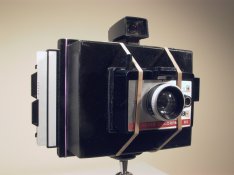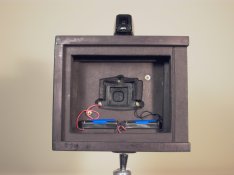Polaroid 4 x 5 point-and-shoot conversion with automatic exposure control
Most Polaroid camera to 4 x 5 inch film conversions are based on 1950s roll film models with rangefinders and mechanical shutter lenses, but hard-bodied plastic Polaroid camera might also be worth considering for conversion. These cameras were once cheap and plentiful, though they now seem to be a bit harder to find. They have helical scale focusing and automatic exposure at 75 and 3000 ISO, which works off a CdS cell supplied with 3 volts DC (usually two AAs, though I switched to AAAs). If you mount the lens and shutter on a new box, all you have to do is add batteries. The power is delivered through lugs under screws at either side of the back of the shutter (see photo).
You have what is effectively a B setting if you cover the CdS cell, although holding your finger over the sensor doesnt work well as (1) you then have to use another finger on your other hand to hold the shutter down and (2) fingers arent that opaque, as you might remember from playing with a flashlight as a child. A special small cap could be made to pop over the sensor for through the lens viewing, but I just used black tape while trying to mount the lens at what I thought was the correct distance from the film. This was one of the more difficult aspects of this project in the end I had to cut the box apart and then screw it back together with shims of varying thickness, so unless you can make very precise measurements and are a very accurate woodworker (Im not, with the tools I have) it may be a good idea to design a box with a lens mount to which you can make subtle adjustments.
Has anyone with an accurate depth gauge ever compared the outside edge to film plane distance of Polaroid pack film & 4 x 5 holders?
100/125 ISO film is probably most practical, given that there is probably no demand for Ilford Delta 3200 in 4 x 5, especially when you could push a 400 speed film, e.g. HP5+, to 3000, or perhaps a bit less with some adjustments to the lighten/darken control. When Polaroid introduced ASA 100 Type 679, they recommended setting the speed selector to 75, then setting the control one notch to darken. I always found Polaroids white/black silhouette lighten/darken icons confusing, which is why I added the + and - symbols.
If you have the nerve to take a lens apart, you could probably substitute an alternative size aperture more suited to 400 ISO films. The older classic/original-style folding Polaroid pack cameras (the 100, 200, 300 and 400 series) have additional film speed settings of 150 and 300 ISO (based solely on a change to the aperture) but are ruled out of this type of simple conversion because they dont have front cell focusing (if youre thinking about adapting one of these cameras, youd probably want to try and keep its rangefinder anyway).
The 114 mm f/9.2 three element plastic Polaroid lenses might be seen as a bit of a drawback. They dont have the bad character of Diana or Holga lenses; theyre designed for sharp contact prints, but seem adequate for 8 x 10 enlargements, depending on how finicky you are.
The camera I adapted was a Colorpack 80 (1971-1976). From the Land list, it looks like the 80 series smaller (nearly) square format (2 ¾ x 2 7/8 in. or 6.9 x 7.2 cm) cameras had the same lenses as the 100 series quarter plate 3 ¼ x 4 ¼ in / 8.5 x 10.8 cm cameras. Once I made a small cutaway at the back of the lens it fully covered 4 x 5, but perhaps a 100 series hard bodied pack film camera might be better. I havent tried to assess how sharp it is at the edges (probably not good!). I also had to file out the plastic mask in the viewfinder to try to match the larger rectangular format. I glued it on the top with epoxy. A simple fold up frame finder might work just as well.
I initially started out trying to fit a 4 x 5 back straight onto the Polaroid body. Using a hacksaw and file I took off the right hand side and bottom of the back, as well as the retaining ridges for the film pack.
Even if the image are was considerably smaller, I figured it would be easier to use standard 4 x 5 film holders and a Jobo 4 x 5 development tank rather than to bother cutting down film and reverting to tray development. (I rejected buying quarter plate film: despite the smaller area, because of reduced demand, it tends to be the same price or more expensive than 4 x 5, if you can get the same emulsions). However I lost some image area at the top, and wasted an awful lot of black tape trying to temporarily light proof a 4 x 5 film holder.
I then decided it was easier just to cut the lens panel off the Polaroid and mount it on a box. I have a Fotoman ground glass holder I used to check the focus (any piece of ground glass in 5 mm thick frame will do). For the back, I used a 12 mm molding on 3mm MDF sheet into which Id filed a groove for the retaining ridge on the film holders. The 12 mm high edge on three sides was a mistake; the Fotoman ground glass holder turned out to be thinner than the average film holder; and because of the bulk of the molding, rubber bands dont hold the film holders all that tight. The back could be improved if I make another one. It would be good to be able to use Grafmatics too.
I still have a supply of flashcubes and it was only after Id finished that I discovered that the camera Id hacked unfortunately no longer seems to fire them. Other than timber and paint, the total cost was about $2 for new battery holders.
The camera weighs 465 g without a film holder (an additional 185 g). The box itself is about 6 x 7 x 4 ½ inches. I was going to add a Velcro strap on the left hand side but havent bothered yet. Its cheap enough to leave in the car and not worry about.
At one stage somebody offered a modification which substituted a variable resistor for the CdS sensor, giving an electronic shutter with an infinitely adjustable shutter speed dial from 1/250 sec to 1 sec and bulb. He also converted the flash sync for electronic flash. The following links to his old page in the Internet Archive:
http://web.archive.org/web/20070525222223/http://home.att.net/~j.kern/polaroid.htm. Im no electronics expert, but perhaps it may have involved not much more than replacing the CdS cell with a standard value resistor and replacing the lighten/darken knob with a new potentiometer, which was then calibrated with a shutter speed tester. If anyone ever works out how to do this, please let the rest of us know!
Philip Jackson





